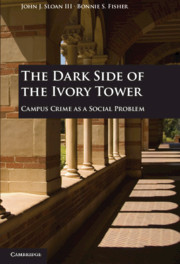Book contents
- Frontmatter
- Contents
- Preface
- Acknowledgments
- The Dark Side of The Ivory Tower
- Chapter One Violence, Vice, and Victimization on American College and University Campuses
- Chapter Two Constructing Campus Crime as a New Social Problem
- Chapter Three Constructing Unsafe and Violent College Campuses
- Chapter Four Constructing the Sexual Victimization of College Women on Campus
- Chapter Five Constructing Postsecondary Institutional Liability for Campus Crime
- Chapter Six Constructing Binge Drinking on College Campuses
- Chapter Seven The Legacy of Claimsmakers
- Index
Preface
Published online by Cambridge University Press: 05 June 2012
- Frontmatter
- Contents
- Preface
- Acknowledgments
- The Dark Side of The Ivory Tower
- Chapter One Violence, Vice, and Victimization on American College and University Campuses
- Chapter Two Constructing Campus Crime as a New Social Problem
- Chapter Three Constructing Unsafe and Violent College Campuses
- Chapter Four Constructing the Sexual Victimization of College Women on Campus
- Chapter Five Constructing Postsecondary Institutional Liability for Campus Crime
- Chapter Six Constructing Binge Drinking on College Campuses
- Chapter Seven The Legacy of Claimsmakers
- Index
Summary
Preface
On February 14, 2008, 27-year-old former graduate student Steven P. Kazmierczak killed 5 people and wounded 16 others after he opened fire in a lecture hall at Northern Illinois University using a shotgun and three handguns. That shooting came almost a year to the day after the worst mass shooting ever on a U.S. college campus occurred at Virginia Polytechnic Institute and State University (Virginia Tech), when 23-year-old Seung-Hui Cho, a senior there, shot and killed 32 students and professors and wounded dozens of others in two separate on-campus incidents before taking his own life. Media reports of shootings, rapes, serious sexual and physical assaults, stalking, and other heinous crimes occurring on college campuses have become common, appearing in news outlets such as the New York Times, the Washington Post, and the Boston Globe and trade publications such as the Chronicle of Higher Education. These publications have also widely reported that alcohol abuse among college students is rampant and has been linked to many deaths from alcohol poisoning or serious injuries suffered while intoxicated. If media reports are to be believed, a “dark side” of the ivory tower of academe has emerged, which threatens the health and safety of millions of college students in the United States.
What is interesting is this: violence, vice, and victimization have occurred on college campuses dating back to the origins of higher education in America. Historical evidence indicates that during the 17th, 18th, 19th, and 20th centuries, murders, lynchings, rapes, violent assaults, serious vandalism, hunger strikes, and riots were not uncommon on college campuses. What is also interesting is that beginning in the 1980s, and continuing to the present, alarm bells started ringing as a variety of sources – including government agencies such as the U.S. Department of Education and the U.S. General Accounting Office – expressed mounting concern about crime and safety on American college campuses. Claims began appearing in mass-media outlets that college students were routinely being murdered, raped, and otherwise victimized on college campuses. Reporters described a “rape culture” that had apparently developed on college campuses. According to these reports, the campus rape culture encouraged college men, enabled by alcohol use or by the provision of drugs such as GHB or Rohypnol (“roofies”) to unsuspecting women, to sexually victimize college women on campus. Student offenders appeared to be committing these types of assault with relative impunity. Parents of student victims claimed to the press that security on college campuses was either lax or nonexistent, which created many opportunities for on-campus victimizations. Students also appeared to be drowning themselves in a sea of alcohol, engaging in dangerous “binge drinking” with far-too-frequent fatal consequences. Finally, claims were leveled by a variety of sources – including student victims, their parents, counselors, and campus officials – that postsecondary administrators, in a cynical effort to maintain the images of their institutions, denied there was a crime problem on their campuses, did little to prevent on-campus victimizations, failed to respond adequately to the needs of campus crime victims, and failed to punish adequately known student offenders.
- Type
- Chapter
- Information
- The Dark Side of the Ivory TowerCampus Crime as a Social Problem, pp. vii - xiiPublisher: Cambridge University PressPrint publication year: 2010

